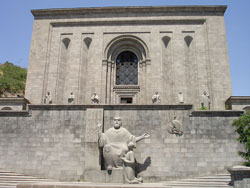Many manuscripts are of great artistic value - “Msho Charntir” (“Mush Collection”), the largest Armenian manuscript, which weighs about 28 kg, and the church calendar of 1434. Armenian manuscripts are rich in miniature images. The paints used in the miniatures were obtained only from natural dyes, and therefore over time they did not fade or lose their original freshness and brightness. Red dye - “vordan karmir”, was obtained from the root worm - cochineal, common in the Ararat Valley. It was exported to different countries of the world and is still known in the vocabulary of artists as carmine. Matenadaran is not only a museum, but also a major research center. Not far from Matenadaran there is a large library where research work is carried out.
Matenadaran

Matenadaran is a unique repository of ancient Armenian manuscripts. The institute was opened in 1959, based on the collection of the Etchmiadzin Monastery. About 17,000 manuscripts are exhibited here, which represent the best examples of ancient Armenian writing and miniatures, fragments of parchments, fossilized fragments of manuscripts found in caves, copies of the first printed books, etc. The oldest manuscript that has survived to this day is the Gospel of Veamor (Virgin Mary ), created in the 7th century.